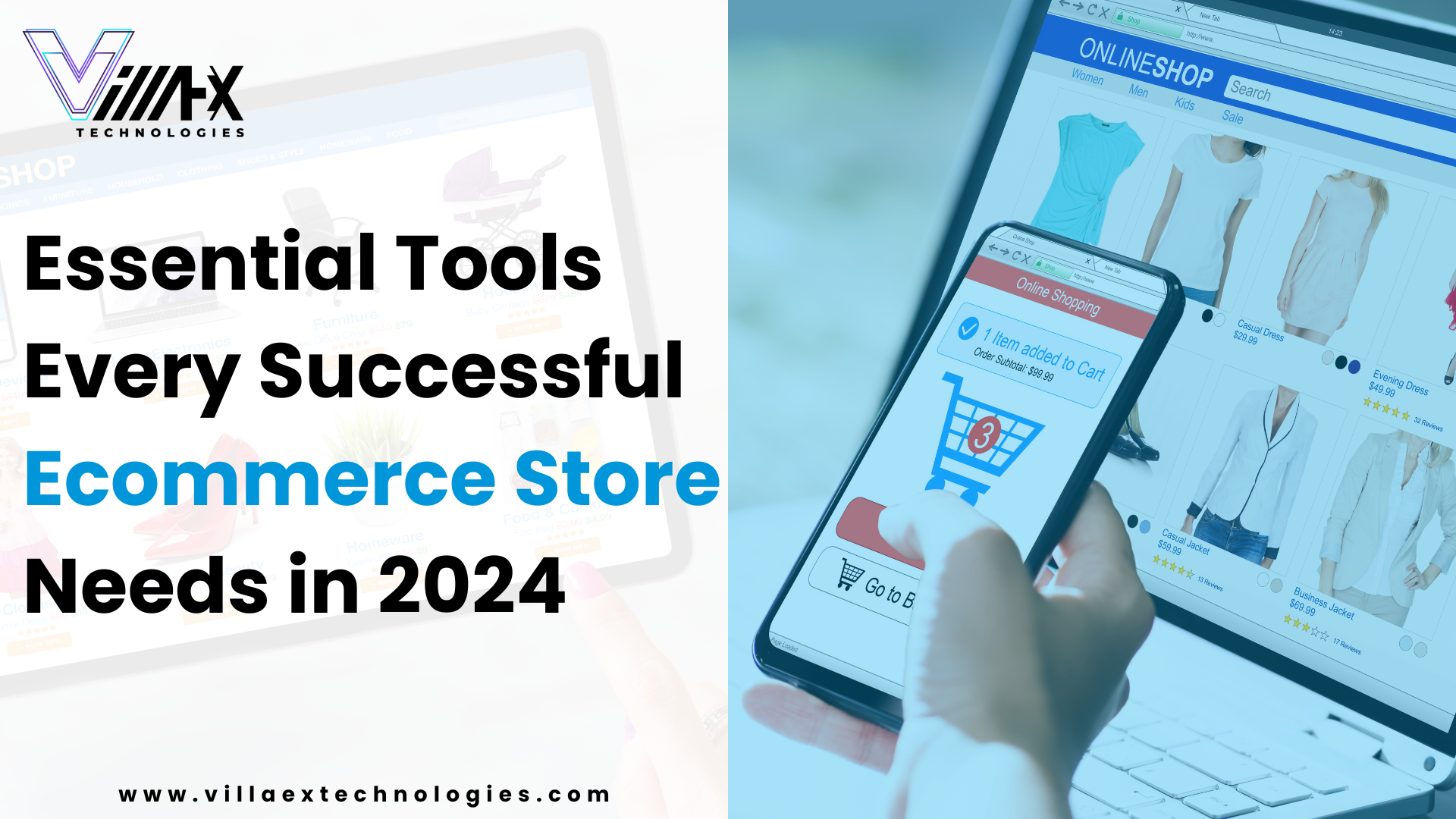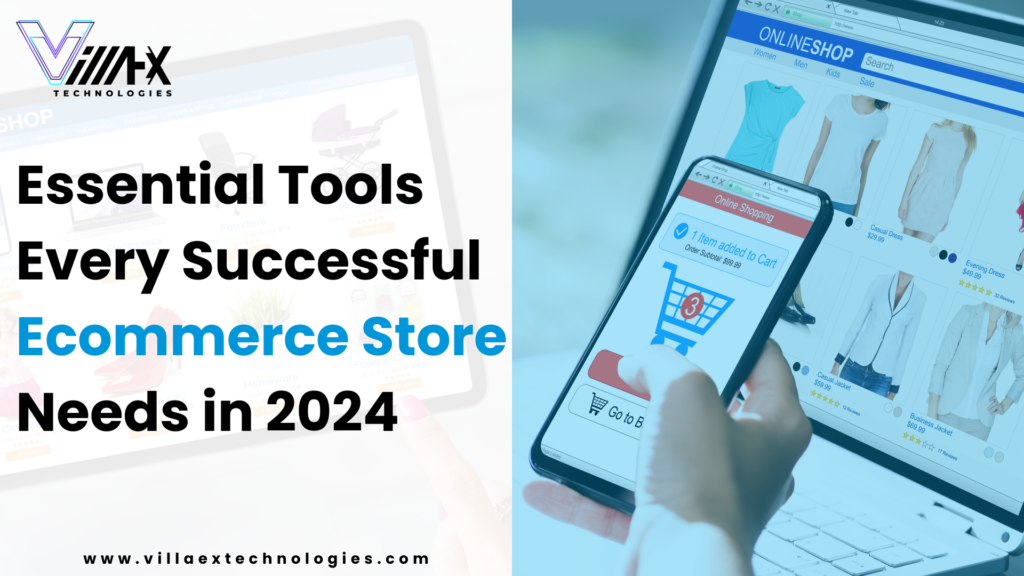As the ecommerce landscape becomes increasingly competitive, utilizing the right tools can drive growth, streamline operations, and improve the customer experience. We’ve outlined the top ten tools every successful ecommerce store needs in 2024, covering categories from sales optimization to customer retention. Let’s explore these crucial solutions in detail.

Advanced Ecommerce Analytics and Reporting Tools
Data-driven insights are invaluable for any online business. An advanced analytics tool gives you a comprehensive view of sales, customer behavior, and website performance.
Key Features:
- Customizable Dashboards: Personalize data insights according to business objectives.
- Real-Time Reporting: Access live data to make quick decisions.
- Predictive Analytics: Forecast future trends and customer demands.
Automated Inventory Management Systems
Effective inventory management prevents stockouts and overstock issues, ensuring a seamless shopping experience for customers. With automation, ecommerce stores can track and replenish inventory with minimal manual input.
Key Features:
- Real-Time Stock Updates: Instantly sync inventory across multiple sales channels.
- Low Stock Alerts: Prevents out-of-stock situations.
- Demand Forecasting: Predicts future inventory needs.
Customer Relationship Management (CRM) Platforms
A powerful CRM is essential for managing customer interactions, enhancing retention rates, and personalizing marketing strategies.
Key Features:
- Customer Segmentation: Allows tailored communication for different customer groups.
- Automated Follow-Up: Nurtures customer relationships through scheduled emails.
- Integrated Communication Channels: Manage emails, social media, and live chat in one place.
Email Marketing Automation
Email marketing remains one of the most effective channels for driving sales. An email automation tool allows stores to send personalized, triggered messages that encourage engagement and conversions.
Key Features:
- Pre-Built Templates: Simplifies email creation with drag-and-drop builders.
- Behavioral Triggers: Sends messages based on user actions.
- A/B Testing: Optimizes email campaigns for higher open and conversion rates.
Conversion Rate Optimization (CRO) Tools
Increasing the percentage of visitors who complete a purchase is vital for growth. Conversion Rate Optimization tools analyze user behavior to refine website elements, encouraging more conversions.
Key Features:
- Heatmaps: Visualize where users click and scroll on a page.
- A/B Testing: Test different versions of website pages.
- Session Recording: Watch user interactions to identify areas of improvement.
Payment Gateways with Fraud Protection
Offering secure and varied payment options improves customer trust. Look for payment gateway providers with advanced fraud protection features.
Key Features:
- Multi-Currency Support: Appeals to an international customer base.
- Fraud Detection Algorithms: Prevents fraudulent transactions.
- Mobile Optimization: Facilitates easy payment on mobile devices.
Shipping and Order Fulfillment Solutions
Efficient fulfillment impacts customer satisfaction and retention. Choose a platform that can streamline shipping processes, manage returns, and track shipments in real-time.
Key Features:
- Automated Shipping Labels: Generates and prints labels quickly.
- Real-Time Order Tracking: Keeps customers updated.
- Return Management: Simplifies the returns process for customers and staff.
Product Information Management (PIM) Systems
A PIM tool centralizes product data, which is critical for multi-channel sales, allowing consistent product details across all platforms.
Key Features:
- Centralized Data Hub: Manages descriptions, images, and pricing.
- Bulk Editing: Speeds up product updates.
- Multilingual Capabilities: Supports global sales efforts.
Social Media Management Tools
Social media is key for brand visibility and customer engagement. A social media management tool can automate posting, track engagement, and monitor brand reputation of ecommerce store.
Key Features:
- Scheduled Posting: Automate posts across multiple platforms.
- Performance Analytics: Measure engagement and effectiveness.
- Social Listening: Monitor brand mentions and conversations.
Customer Support and Live Chat Software
Offering prompt support is vital to customer satisfaction. Live chat and helpdesk solutions improve customer service responsiveness and build trust.
Key Features:
- Instant Chat Assistance: Provides real-time support for customers.
- Self-Help Options: Reduces support tickets by offering FAQs and knowledge bases.
- Multi-Channel Support: Integrates with email, phone, and social media.
Search Engine Optimization (SEO) Tools
Ranking well on search engines drives organic traffic and helps customers find your ecommerce store. A comprehensive SEO tool can improve keyword strategy, content optimization, and technical SEO aspects.
Key Features:
- Keyword Research: Discover high-ranking keywords to attract more visitors.
- Content Optimization Suggestions: Improve existing pages to match search intent.
- Backlink Analysis: Monitor backlinks and competitors’ link profiles for better SEO authority.
Personalization and Recommendation Engines
Customers are more likely to purchase when they feel the ecommerce store understands their preferences. Personalization tools help create tailored experiences, from product recommendations to targeted promotions.
Key Features:
- Product Recommendations: Suggest items based on past purchases or browsing history.
- Dynamic Content: Display personalized messages and offers.
- Segmentation-Based Campaigns: Personalize campaigns based on customer demographics and behaviors.
Loyalty and Rewards Program Management
Retaining loyal customers is generally more cost-effective than acquiring new ones. A loyalty program tool incentivizes repeat purchases by offering rewards for various actions, such as purchases, referrals, or social media engagement.
Key Features:
- Points-Based System: Earn rewards based on customer actions.
- Referral Programs: Encourage customers to refer friends and family.
- Integrations with CRM: Align loyalty program data with customer profiles for further personalization.
Marketplace Integration Software
Many ecommerce stores expand to marketplaces like Amazon, eBay, and Walmart. Marketplace integration tools simplify the process by synchronizing product listings, inventory, and orders across various platforms.
Key Features:
- Centralized Inventory Management: Syncs stock levels across multiple marketplaces.
- Automated Listings: Upload and update products across platforms seamlessly.
- Order Consolidation: View all orders in one place for simplified fulfillment.
Retargeting and Paid Advertising Platforms
Retargeting helps bring back customers who visited but didn’t convert. Paid advertising platforms allow precise targeting, from Google Ads to social media ads, and can maximize ROI when properly managed.
Key Features:
- Audience Segmentation: Target ads to specific customer groups.
- Dynamic Retargeting: Show ads based on specific pages visited.
- ROI Analytics: Track performance and return on investment in real-time.
Multi-Channel Customer Feedback Tools
Gathering and analyzing customer feedback is critical for continuous improvement. Multi-channel feedback tools gather insights across email, social media, and post-purchase surveys to refine operations.
Key Features:
- Survey Creation: Design and deploy surveys to capture customer insights.
- Feedback Aggregation: Centralizes data from various channels for easy analysis.
- Sentiment Analysis: Uses AI to understand customer satisfaction and areas needing improvement.
Subscription Management Software
For stores offering subscription-based products, a subscription management tool ensures smooth recurring billing, customer retention, and insight into subscriber preferences.
Key Features:
- Automated Billing: Handles monthly, quarterly, or annual billing cycles.
- Subscription Pause Options: Allows customers to temporarily suspend subscriptions.
- Churn Analysis: Identifies reasons behind subscription cancellations.
Content Management Systems (CMS)
An efficient CMS enables ecommerce teams to publish and update product pages, blogs, and landing pages effortlessly. This is crucial for content marketing strategies and SEO.
Key Features:
- Drag-and-Drop Editing: Simplifies page building without coding.
- SEO-Friendly URL Structures: Improves site visibility.
- Content Scheduling: Plan and schedule content publication for optimal engagement.
Cybersecurity and Compliance Tools
Protecting customer data and adhering to regulations like GDPR is essential. Cybersecurity tools help ecommerce businesses maintain trust and avoid data breaches.
Key Features:
- Data Encryption: Protects sensitive information during transactions.
- Compliance Tracking: Ensures compliance with privacy regulations.
- 24/7 Threat Monitoring: Constantly watches for potential vulnerabilities.
Return Management Solutions
Return management software improves the customer experience and streamlines the return process, which is essential in maintaining positive relationships and encouraging repeat purchases of Ecommerce Store.
Key Features:
- Automated Return Labels: Simplifies the process for customers and staff.
- Return Analytics: Provides insights on the most returned items.
- Multi-Channel Return Handling: Supports returns from various sales channels.
“Discover the essential tools for a successful ecommerce store in 2024, from inventory management to customer support, personalization, SEO, and cybersecurity”



More Stories
Using a Virtual Office for Your GST Registration
Hellstar Hoodie has become an iconic piece in
Why Should Consider Buying Dog Supplements